Squash
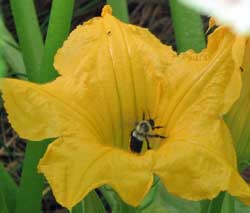 ©Janet Allen
©Janet Allen Bumblebee pollinating squash
Summer squash is one of our favorite foods, especially patty pan squash. This is the only squash we have grown in the past few years. Summer squash is easy to grow but pests sometimes make it frustrating. Here's an insect that is clearly not a pest.
Squash needs to be pollinated or no fruit develops. Here, a bumblebee is doing the job.
Squash bees, of course, are also excellent pollinators.
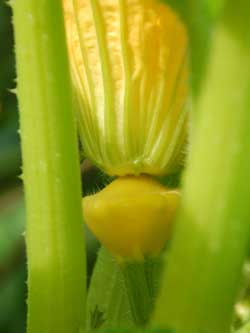 ©Janet Allen
©Janet Allen Patty pan squash developing
We have seen patty pan squash at the farmer's market that were picked when very small (not much bigger than a golf ball).
We try to pick ours when they are three to four inches in diameter. Bigger than that they begin to have seeds, but even then they are tender.
The harvest begins in early July and continues until the first frost.
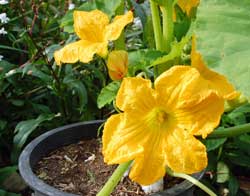
Squash in container
Squash take up a lot of space and one year we tried growing some in containers. They grew well and produced earlier than those in the garden beds, but they soon became heavy and tended to fall over the side of the container. Production over the whole season was much better with those grown in the garden beds. Those in containers also need to be watered on a daily basis at least. We have not continued the container experiment.
Problems with borers
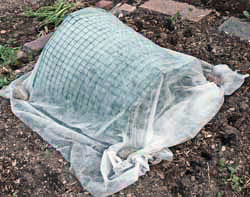 ©Janet Allen
©Janet Allen Squash protected by row cover
We have not yet been able to escape damage from squash vine borers. Invariably, as the season progresses there comes a day when the earliest planted summer squash plants begin to wilt. If left unattended they are soon finished.
Obviously if we could keep the insect that produces the borer off of the plants the squash will be fine. The photo shows what we did.
We place row cover material over the seedling as soon as we planted it. Assuming that was all that was needed, we waited until the plants began to flower and then uncovered them. This is necessary for the flowers to be pollinated and form fruit. Unfortunately the wasp-like insect that lays the eggs for the squash vine borer was still active when we uncovered it, and in due course the plant succumbed. More was needed.
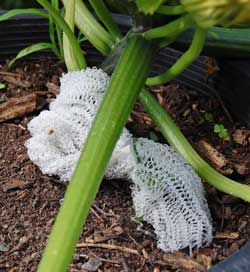 ©Janet Allen
©Janet Allen Cheesecloth around squash stem
The next year, I wound a narrow strip of cheesecloth around the base of the plant in the hope that it would prevent the insect from getting to the base of the plant to lay eggs. I also covered two of them with row cover material.
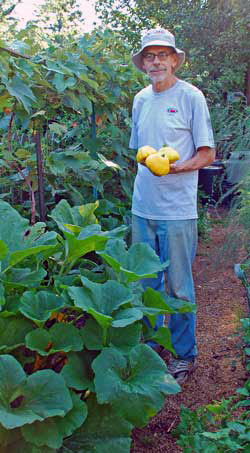 ©Janet Allen
©Janet Allen With squash I harvested
It seemed to work, but just as I was about to report that my plan was successful, parts of the plants began to wilt and fairly soon they were simply not producing very much. When I looked I could see that borers had dug their usual tunnels in the stem.
But the cheesecloth must have delayed them for a while, with the result that we had over a hundred pounds of patty pan squash that year.
The next year we began to find the borer. Admittedly this was not until one plant was clearly beginning to decline. In fact the plant was hardly still attached to its root. When the stem was examined and dissected there were at least nine borers in it. I began to examine the other squash plants and found evidence of borers in them also. I dug into the stems with a knife, nearly severing the stem, in fact, and squashed the borers that I found there. I then put the stems back together and covered them with soil. They survived this treatment for quite some time, much to my amazement.
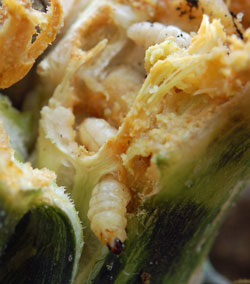 ©Janet Allen Squash vine borer
©Janet Allen Squash vine borerWhen do the borers arrive? Our past experience was that squash seeds planted when the first ones were wilting survived. This suggests that the eggs for the borer are laid over a limited span of time and that a later planting after that time will survive. However, one year the later plantings were also infected but I did not wait until the first ones were dying.
Around June 20th is the recommended time to begin looking for evidence of the borers.
Maybe the combination of covering, using cheesecloth, and inspections beginning June 20th will result in a season long crop of squash. Two or three plants should be enough.
Harvest record
| YR | LB | Notes |
| 15 | ||
| 14 | 85 | |
| 13 | 36 | We grew just two plants this year, which provided all the squash we needed |
| 12 | 46 | |
| 11 | 60 | |
| 10 | 109 | |
| 09 | 20 |
